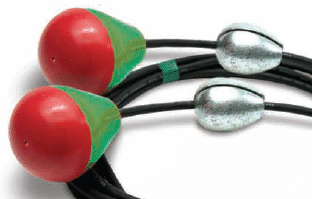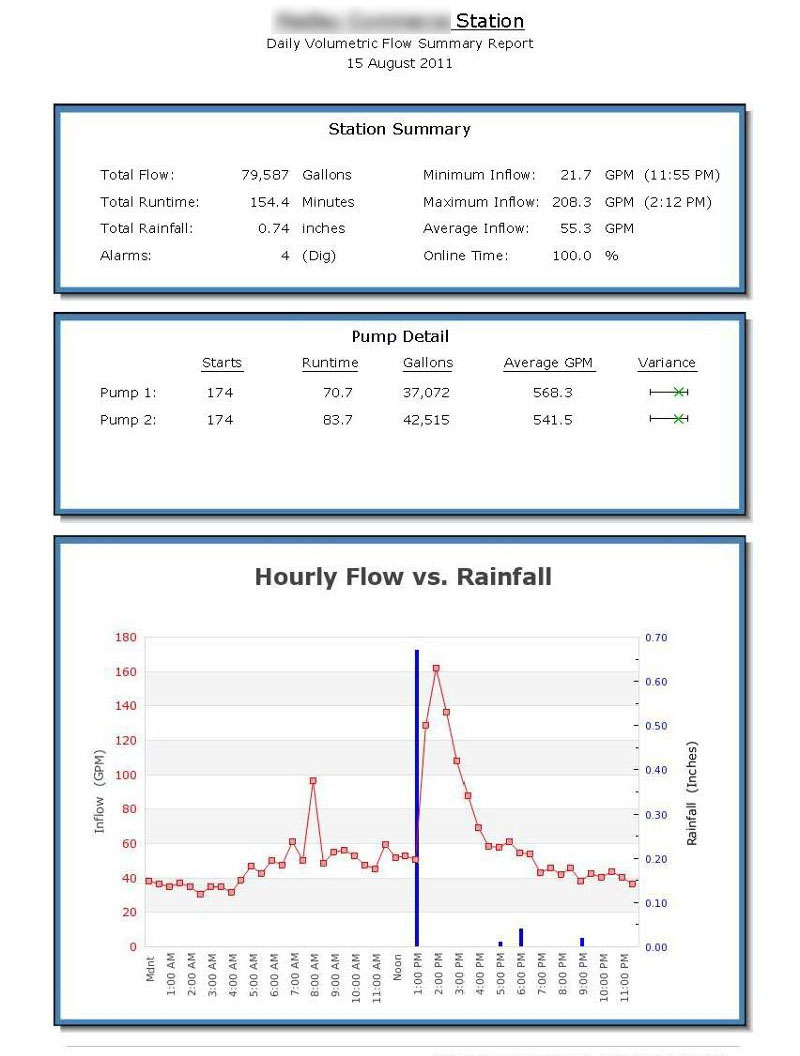|
New Product

Mercury-Free Floats
Part #468
Over the past few years, many state governments have enacted legislation prohibiting manufactured products containing mercury, including float switches. The laws are intended to reduce the possibility of mercury release into the environment. Mission values the protection of our natural surroundings and now offers floats containing mechanically-activated switches, making it more convenient for the customer to stay in accordance with these regulations while monitoring liquid levels. The new floats are ETL listed and suitable for use in Class 1, Division 2, Groups A, D, C, D, T6 hazardous locations. According to the IMERC 2010 document, "Mercury Use in Switches and Relays", the following states have passed legislation banning relays and switches containing mercury: California, Connecticut, Illinois, Louisiana, Maine, Massachusetts, Minnesota, New Hampshire, Rhode Island, New York, and Vermont. |
| |
----------------------------------------- Transmissions Sent by Mission Field RTUs in the Past 30 Days: 106,485,180
------------------------------------------
Trade Shows
See us at WEFTEC October 17 - 19 Los Angeles, CA Booth 4700, West Hall
October 26
Web Portal II: Supergraph, Reporting, Volumetric Flow, Other Advanced Options
November 2
Survey of Features
November 16 Web Portal I: Notification, Unit Setup Options November 30 Special Topics - TBA 
|
|
|
| Can Cellular SCADA Withstand Earthquakes and Hurricanes? Two recent natural disasters have tested the cellular networks in different ways. A 5.8 magnitude earthquake followed by Hurricane Irene struck the Eastern United States this past August. Call surges by cell phone users after the earthquake made voice communications difficult if not impossible. Power outages caused by Hurricane Irene presented a different set of challenges to cellular providers. Cellular SCADA demonstrated its reliability in both instances.
Earthquakes are unannounced phenomena that leave little time to react and no time to prepare. Disasters that happen without warning often cause "mass calling events" that are essentially communications traffic jams. Cellular voice service was disrupted in Washington D.C. and surrounding areas for over an hour after the earthquake due to high call volume, which has prompted an FCC inquiry. Because text data over cellular has lower bandwidth requirements than voice, text (SMS) messages were able to transmit during the disruption when voice was not. The new "Get Tech Ready" web resource from FEMA recommends sending text messages during emergencies because they "often have the ability to work in the event of a phone service disruption." While different than SMS, Mission SCADA has similar bandwidth requirements and utilizes the same cellular data networks for its service making it reliable during mass calling events.
 |
|
The earthquake occured at 1:52 PM EST. Connectivity never faltered for this Washington, D.C., area customer.
|
Mission customers in Maryland and Virginia reported that they maintained connectivity throughout the earthquake when voice communications were down. In fact, the Mission RTU closest to the epicenter (within 22 miles) did not show a single disconnection or lost message. As illustrated above, Mission RTUs in the Washington, D.C., area maintained connectivity as well. Hurricanes stress the networks in very different ways. During and after a hurricane, disruptions in cellular communications can be caused by flooding that disconnects circuitry, power outages that last long enough to drain backup power sources, or high winds that cause damage to infrastructure. Because the hurricane path is forecast well in advance, cellular providers have time to prepare. Carriers prepare by pre-positioning crews and equipment for rapid deployment to repair damaged infrastructure.
 |
| Hurricane Irene captured from a Mission user's web portal at the height of the storm. The green Mission icon indicates units transmitting during a direct hit. |
After Hurricane Irene, 466,000 Baltimore Gas and Electric customers in Annapolis and greater Anne Arundel County (MD) experienced power outages. Over half the homes in the county were without power at the height of the storm. The city of Annapolis uses Mission to monitor lake levels. Marcia Patrick, acting Director of Public Works, reported, "We never lost communications with the Mission system and were able to keep a constant watch on levels in case we needed to notify residents of an emergency." Approximately 1400 cell sites were offline and over 1000 additional cell sites were operating on backup power in the hardest hit states of Maryland, North Carolina, and Virginia. Cell towers are frequently equipped with backup power sources that enable them to continue operating until power is restored. When towers are damaged, carriers deploy COWs (cell sites on wheels) to provisionally replace offline towers until they are repaired. The key to maintaining cellular network connectivity when a hurricane hits is preparedness. Overall, voice and data communications fared well throughout Hurricane Irene due to the rapid emergency response of cell carriers. According to a CNET and CBS News report titled "Cell Phones 1, Hurricane Irene 0," the preparations paid off. A more apt title to this article might be "Mission SCADA 2, Natural Disasters 0." |
|
|
New Report Summarizes Station Data
The engineers of Mission Communications have added the "Daily Volumetric Flow Summary Report." More than just a flow report, it centralizes the vital statistics of a pump station. Like all other Mission reports, it was inspired by a customer's request. Mission does not charge extra for adding this type of functionality to the system when it is likely to benefit other users. Our service is meant to grow with customers' needs.
Bruce Neerhof, Public Works Superintendent for Kohler Village (WI), provided the inspiration for this new report. He needed a report that summarized pump station performance graphically and with greater detail than what was available. "I was most concerned with studying inflow and infiltration," Mr. Neerhof said, "but also found this report useful in uncovering illegal connections. I get piece of mind in knowing that I can briefly check this report along with my morning emails and feel secure in my water pump stations."
 |
|
The Daily Volumetric Flow Summary Report centralizes all monitored pump station activity.
|
A primary function of this report is to present volumetric daily flow calculations without the need for analog or pulse flow meters. Volumetric flow is calculated by taking the surface area of the sump and the change in level during a pump cycle (on/off/on) to accurately estimate inflow. Mission customers report that the volumetric flow calculations are accurate to within 5% of analog and pulse flow meter readings.
In addition to providing timestamped minimum, maximum, total, and average volumetric flow rates, the "Station Summary" section highlights runtime, rainfall, alarm, and connectivity statistics for the station. The "Pump Detail" section drills down to show the operation of each pump. One can quickly assess pump health by checking its starts, runtime, flow statistics, and variance at a glance. An important report feature meant to detect potential stormwater inflow at the station is the "Hourly Flow vs. Rainfall" graph. It does exactly what its title implies, graphically displaying the correlation between hourly flow and rainfall in an easy-to-read format. By default, rainfall data comes from your local NWS station, although inputs from local tipping bucket equipped RTUs can be used instead. Because real-time pump start data is needed to calculate volumetric flow, this report is only available for M-800 RTUs. For M-110 RTUs without analog or pulse flow meters, other reports are available which present flow calculations using the GPM method. This method derives flow by multiplying pump run time by GPM rating and is dependent upon calibrated or certified GPM ratings for increased accuracy. A M-110 RTU can be upgraded over the air to a M-800 RTU if the volumetric method is preferred. This report is available on request and must be activated by Mission tech support. Mission is currently working to enable customers to activate this feature through the website. Once activated, the report is accessible in the "reports menu" of your Mission web portal. Contact Mission tech support for more information. |
 |
| Stephen May, Lenawee County Drain Commissioner |
Saving Time, Manpower, and Money Since adding Mission M-110 RTUs to 40 lift stations, Lenawee County Michigan has saved time, manpower, and money. As County Drain Commissioner, Stephen May runs a utility responsible for maintaining 707 separate drainage districts encompassing over 1,500 miles of drains. Mission has helped him reduce site inspections, find holes in riser pumps more quickly, and resolve a major billing dispute with the power company. Before installing the Mission RTUs, utility workers in Lenawee County conducted site inspections at 40 lift stations two or three times a week. Site inspections have now been reduced to once a week, freeing up man-hours otherwise spent driving to and inspecting lift stations. Utility workers are using this extra time to catch up on maintenance that might otherwise be neglected due to budget issues and schedule conflicts. The utility also identified stations needing repair more quickly by using wet and dry season run time comparisons compiled by Mission. After one recent alert, crews pulled a pump and discovered a large hole in the riser pipe. May reported, "The hole would have been found eventually, but the run time variance notification alerted us to the problem much sooner." Lenawee County avoided power company overcharges when their Mission units indicated power fluctuation problems with one particular station. The power company checked their equipment and claimed that everything was working correctly on their end. According to May, "The power problem occurred again about a month and a half later. We were able to show the power company the readings from our Mission reports proving that the problem was on their end....and [they] adjusted the billing. The Mission unit more than paid for itself with that single instance." |
|
|
Mission Devices Not Affected by
FCC Narrowbanding Requirements
The FCC has mandated that all private radios licensees operating on the 25 kHz bandwidth migrate to a 12.5 kHz channel by January 1, 2013. Phase Two of this narrowbanding requirement will be implemented at a later date. Utilities relying on private radio for their SCADA systems may be required to replace radio equipment and apply for new licenses. Because Mission SCADA uses cellular networks instead of private radio, Mission devices are not affected by these requirements.
 |
| Narrowbanding allows more users to operate in the same limited spectrum but may require radio or configuration upgrades. |
The move to 12.5 kHz is likely to result in a reduction of signal strength of approximately 3dB. Compensating for this loss may require increased power, additional transmitter locations, and additional path studies for new equipment. Path studies are usually conducted prior to installation to ensure that major obstructions such as hills or buildings are taken into account. Difficult terrain can increase installation and on-going maintenance costs. Replacing equipment can represent a significant investment. With private radio, upfront costs are higher than with cellular and maintenance costs can be less predictable. Cellular SCADA users benefit from the economies of scale that large cell carriers provide. Maintenance and upgrade expenses for cellular service are built into the monthly service fees, allowing SCADA providers like Mission to offer predictable pricing. Cellular SCADA also allows local stakeholders to focus on what they do best rather than be burdened with upgrading a communications network and dealing with regulatory hurdles. The cellular providers are responsible for maintaining the integrity of cellular networks, improving infrastructure, and restoring communications after natural disasters. Local stakeholders are responsible for all of this when they use private radio. For more information on narrowbanding see FCC 'Tech Topic 16,' the FCC VHF/UHF Narrowbanding Information page, or contact your Mission Regional Manager. |
|
|
|
|